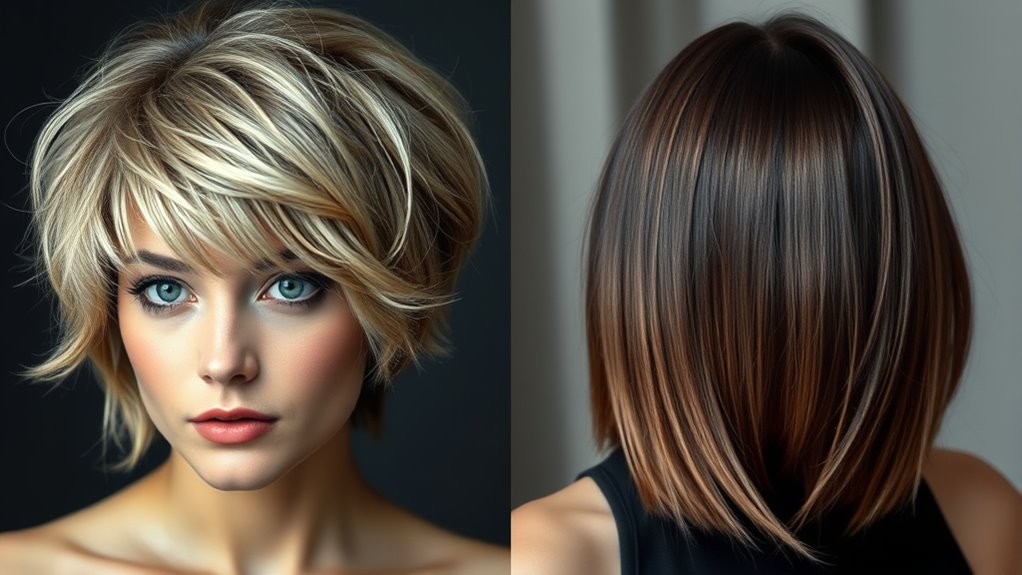The Wolf Cut offers a messy, textured look with layered, choppy ends perfect for thick, wavy, or curly hair, creating a rebellious vibe. In contrast, the Butterfly Cut features long, smooth layers for a sleek, romantic style, ideal for straight or slightly wavy hair. Your face shape and personal style influence which one suits you best, and each requires different styling techniques. Keep exploring to discover which cut matches your natural features and style goals.
Key Takeaways
- The Wolf Cut is layered, messy, and textured, ideal for voluminous, wavy or curly hair, while the Butterfly Cut features long, smooth layers for a polished look.
- Wolf Cut offers a rebellious, edgy vibe with tousled styling, whereas Butterfly Cut emphasizes elegance and sleekness with straightening and smoothing products.
- The Wolf Cut suits thick, textured hair and oval or square faces, while the Butterfly Cut works best with straight or slightly wavy hair and oval or long faces.
- Styling the Wolf Cut often involves sea salt sprays and diffusers for a messy effect, whereas the Butterfly Cut benefits from smoothing serums and straightening irons.
- Maintenance varies: Wolf Cut may require more effort to keep its tousled appearance, while Butterfly Cut offers a more low-maintenance, sleek style.

If you’re exploring trendy hairstyles, the Wolf Cut and Butterfly Cut are two bold options that have captivated many. Both styles bring a fresh, edgy vibe, but they differ markedly in how they complement your hair texture and face shape. Understanding these differences can help you choose the one that suits you best. The Wolf Cut combines layered, shaggy elements with choppy ends, creating a messy, textured look that works well for various hair textures. If you have thick, wavy, or curly hair, this cut can enhance your natural volume and movement, giving you a wild, effortless style. For those with fine or straight hair, adding layers can create the illusion of fullness and dimension, but it might require more styling to achieve the desired tousled effect. When considering face shape, the Wolf Cut is particularly flattering for oval, square, or heart-shaped faces, as the layers can soften angular features or elongate the face. If you have a round face, however, you might want to opt for longer, face-framing layers to avoid emphasizing width.
The Butterfly Cut, on the other hand, is characterized by long, flowing layers that create a soft, layered silhouette reminiscent of butterfly wings. This style emphasizes smoothness and grace, making it ideal for those with straight or slightly wavy hair. It tends to be less textured than the Wolf Cut but offers a romantic, polished appearance. If your hair is naturally straight, the Butterfly Cut allows you to achieve a sleek, shiny finish with minimal effort. For wavy hair, it can enhance natural waves, adding dimension without sacrificing elegance. When choosing this cut based on face shape, it suits oval, long, or heart-shaped faces best because the long layers help frame the face gently and balance proportions. For round faces, longer layers can elongate the look, creating a more balanced appearance, while avoiding too much volume around the cheeks.
In styling, the Wolf Cut often calls for textured products, sea salt sprays, or diffusers to emphasize its tousled, messy charm. Meanwhile, the Butterfly Cut might require smoothing serums or straightening irons for a sleek finish or light styling products to enhance natural waves. Both cuts offer versatility but cater to different preferences—whether you want an intentionally messy, rebellious look or an elegant, flowing style. Additionally, self watering plant pots are a popular choice for low-maintenance plant care, which can be a great addition to your home decor. Ultimately, your choice depends on your hair texture and face shape, as well as how much effort you’re willing to put into styling daily. Both hairstyles promise to turn heads, so consider your natural features and personal style to find the perfect fit.
Frequently Asked Questions
Which Face Shapes Suit the Wolf Cut Best?
You’ll find the wolf cut suits oval, square, and heart-shaped faces best. For face shape tips, opt for layers that soften jawlines or highlight cheekbones. Consider hair texture considerations too—wavy or curly hair enhances the shaggy, messy look, while straight hair can be styled for more volume. Ultimately, the wolf cut’s versatile, so it can work with various face shapes if you tailor the length and layers accordingly.
Can the Butterfly Cut Be Styled for Formal Occasions?
Absolutely, you can style the butterfly cut for formal occasions. Think of it like dressing up a versatile piece of jewelry—add sleek waves, a polished finish, and elegant accessories like clips or pins. I once attended a wedding with a butterfly cut styled in soft, glossy waves paired with delicate earrings, and I received so many compliments. With the right formal styling and accessory options, this cut can look sophisticated and chic for any event.
How Do I Maintain Volume in a Wolf Cut?
To maintain volume in your wolf cut, use texturizing techniques like backcombing or applying a light layer of dry shampoo at the roots. Incorporate volumizing products such as mousse or root-lifting sprays to boost fullness. Avoid heavy conditioners that weigh hair down. Blow-dry with a round brush, lifting at the roots, and finish with a flexible-hold spray to keep your style voluminous and fresh all day.
Are There Any Hair Types That Don’T Work Well With the Butterfly Cut?
Certain hair types, like very fine or thin hair, might not work well with the butterfly cut because it can make your hair look flat and lack volume. If you have scalp sensitivity, layered cuts like this might irritate your scalp more easily. Thick, coarse, or curly hair usually holds the style better and maintains its shape without causing discomfort. Always consult your stylist to see what suits your hair texture and scalp needs.
What’s the Best Way to Transition Between These Cuts?
To smoothly switch between these cuts, you need to play it by ear and use blending techniques to soften the changeover. Start by trimming or layering to create harmony between styles. Accessory choices like clips or headbands can also help bridge the look while you adjust. Keep your style flexible, and don’t be afraid to experiment—this approach helps you find the perfect balance as you go from one cut to the other.
Conclusion
So, whether you choose the wild, rebellious charm of the wolf cut or the delicate elegance of the butterfly cut, just remember—your hair doesn’t have to be a reflection of your personality… or does it? Either way, styling is your playground. Just don’t be surprised if your friends start calling you “the art project” or “the butterfly in the room.” After all, hair is only as expressive as your willingness to endure a few styling struggles.








